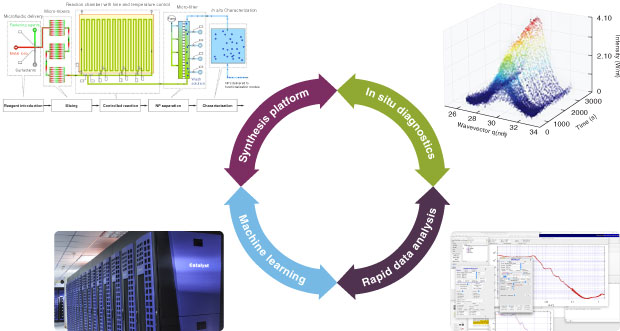Thomas Han (16-ERD-019)
Executive Summary
We are developing a new capability that will allow efficient scaling and production of advanced materials by integrating automated information extraction, machine learning, data analytics, and experimental-materials synthesis and characterization. This research could lead to discovery of new synthesis processes with applications in weapon systems, energy, and climate research.
Project Description
The importance of discovery of novel materials has recently been emphasized with the launching of the Materials Genome Initiative by the White House in 2011. The goal of the initiative is to deploy advanced materials twice as fast and at a fraction of the cost by integrating computational and experimental tools, digital data, and collaborative networks. New materials with unique properties are synthesized every year by researchers around the globe. However, advanced materials produced with discovery research and development often do not transition to industry for application integration, partly because of scaling the synthesis process to the large-scale quantities required by industry. One reason why an experimentalist cannot reproduce high-quality materials at the larger scale is because of a lack of understanding of the critical reaction parameters involved in the synthesis. In a given synthesis of a material, there are a number of reaction parameters, including specific chemicals, chemical concentrations, temperatures, additives, reaction times, and solvents, just to name a few. It is often difficult and time consuming to experimentally pinpoint the most important parameters to obtain the desired results. If we can discover and validate the most relevant critical reaction parameters from existing literature using computational and data-processing techniques, we will have made a significant leap in the field of materials synthesis and informatics. We will explore how to successfully transition academic research and development processes to pre-pilot plant scales by understanding the fundamental principles in materials synthesis. We will do this by extracting and experimentally verifying correlations between processing, structure, and function in the existing literature by integrating automated information extraction, machine learning, data analytics, and experimental materials synthesis and characterization (see Figure 1).
We will leverage Lawrence Livermore National Laboratory's expertise in advanced materials synthesis and computational processes to develop a new capability that will enable efficient scaling and production of advanced materials to meet current and future demands. For example, we intend to address solution-based synthesis of metal, metal oxides, and magnetic materials. More specifically, we will address the shape and size evolution of these materials from the nanometer to micrometer scales. Transitioning a synthesis from a small to a larger scale is often difficult because of the precipitous drop in the quality of the materials as the scale of synthesis increases. Our research effort will provide a science-based material-synthesis approach to scale up high-quality materials from a wealth of small-scale materials synthesis literature, which will have a significant impact in numerous applications. In particular, we expect to develop information- and observation-driven processes to synthesize materials with high quality and quantity to meet the demands of both the internal and external community. Our research may also lead to discovery of new synthesis processes that have yet to be explored.
Mission Relevance
Our research effort will enhance current Laboratory capabilities in the core competency of advanced materials and manufacturing by addressing our limited capability to synthesize large quantities of advanced materials to supply multiple programs and external commercial and government entities. This research also supports the DOE goal to transform our understanding of nature and strengthen the connection between advances in fundamental science and technology innovation. Material we generate can impact several mission-focus areas, including stockpile stewardship science with materials relevant to weapon systems, energy security with magnetic materials to improve energy applications, and inertial fusion science and technology with materials relevant to laser target development. Computational and informatics processes we will develop support the core competency in high-performance computing, simulation, and data science.
FY17 Accomplishments and Results
In FY17 we (1) successfully demonstrated machine-learning algorithms for extraction of experimental sections, chemical entities, and images; (2) established a web-crawl process to capture documents pertaining to materials synthesis, and began performing analysis of extracted entities; and (3) evaluated various synthesis platforms to rapidly screen many reaction conditions learned from automated information extraction and data analyses to quickly use captured information for the production of high-quality materials.
Publications and Presentations
Han,T. 2016. "Multiphase Separation of Copper Nanowire." Chemical Communications 52:11627–11630. doi:10.1039/c6cc06228h. LLNL-JRNL-698864.
——— 2017. "Tunable Amorphous Photonic Materials with Pigmentary Colloidal Nanostructure." Advanced Optical Materials 5 (7):1600838. doi:10.1002/adom.201600838. LLNL-JRNL-715397.






